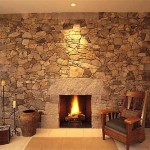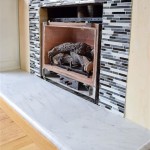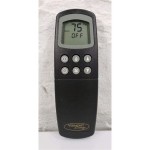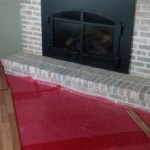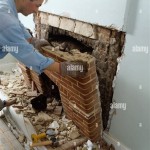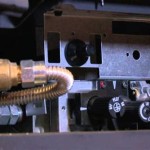Smoke From Fireplace: Causes, Prevention, and Troubleshooting
A fireplace can be a source of warmth and ambiance in a home, particularly during colder months. However, a common problem associated with fireplaces is smoke escaping into the living space instead of rising through the chimney. This issue can be irritating, unhealthy, and a sign of potential safety hazards. Understanding the causes of fireplace smoke problems, implementing preventive measures, and knowing how to troubleshoot common issues is crucial for ensuring safe and efficient fireplace operation.
Draft Issues and Chimney Functionality
Effective fireplace operation depends on a proper draft, which is the upward flow of air through the chimney. This draft is created by the temperature difference between the warm air inside the chimney and the cooler air outside. When the draft is inadequate, smoke can be forced back into the room. Several factors can contribute to poor draft, including chimney obstructions, cold chimneys, and negative pressure within the house.
Chimney obstructions are a frequent cause of smoke problems. These obstructions can include accumulated creosote, bird nests, leaves, or other debris. Creosote is a byproduct of burning wood, and it accumulates on the inner walls of the chimney over time. Heavy creosote buildup can significantly restrict airflow and create a fire hazard. Regular chimney inspections and cleaning are essential to remove creosote and other obstructions. A certified chimney sweep should be employed for this task, as they have the necessary tools and expertise to safely and effectively clean the chimney.
A cold chimney can also inhibit draft. When the chimney is cold, the air inside it is dense and heavy, making it difficult for the warm smoke from the fire to rise. This is especially problematic when the fireplace has not been used for a long time. To warm up the chimney, a homeowner can try holding a lit torch or rolled-up newspaper inside the firebox near the flue for a few minutes. This preheating process can help establish a draft before starting a full fire. It is important to exercise caution when using a torch or newspaper to avoid accidental fires.
Negative pressure within the house can counteract the chimney draft. Negative pressure occurs when more air is being exhausted from the house than is being supplied. This can be caused by exhaust fans in kitchens and bathrooms, clothes dryers, and tightly sealed homes. When negative pressure is present, air is drawn into the house from any available source, including down the chimney. To mitigate negative pressure, one can try opening a window slightly in the room where the fireplace is located. This will provide an alternative source of air and reduce the tendency for the chimney to draw air in the wrong direction.
Wood Selection and Burning Practices
The type of wood burned in the fireplace and the way it is burned significantly impact the amount of smoke produced. Using the wrong type of wood or burning it improperly can lead to excessive smoke and creosote buildup. Seasoned hardwood is the best choice for fireplace burning, while softwoods and unseasoned wood should be avoided.
Seasoned hardwood has been dried for at least six months, typically longer. This drying process reduces the moisture content of the wood, making it burn hotter and cleaner. Dry wood produces less smoke and creosote than wet wood. Signs of seasoned wood include cracks in the ends, a dull thud when struck against another piece of wood, and a lighter weight compared to green wood. Common hardwoods used for fireplaces include oak, maple, ash, and birch.
Softwoods, such as pine and fir, contain a higher resin content than hardwoods. When burned, these resins produce more smoke and creosote. Unseasoned wood, also known as green wood, has a high moisture content, which also leads to excessive smoke and creosote formation. Burning green wood is inefficient and can damage the chimney over time. Therefore, it is crucial to use only seasoned hardwood in the fireplace.
Proper burning practices also contribute to a cleaner and more efficient fire. Start the fire with kindling and smaller pieces of wood to establish a strong draft. Once the fire is burning well, add larger logs gradually. Avoid overloading the firebox, as this can smother the fire and increase smoke production. Position the logs towards the back of the firebox to allow for better airflow. A well-maintained fire burns brightly and produces minimal smoke. It is also important to ensure adequate airflow around the logs by not packing them too tightly.
Fireplace and Chimney Construction and Maintenance
The design and condition of the fireplace and chimney play a critical role in their ability to function effectively and safely. Cracks, leaks, or improper construction can lead to smoke leakage into the house. Regular inspections and maintenance are essential to identify and address potential problems before they become serious.
Fireplace and chimney construction must adhere to building codes and safety standards. The flue should be appropriately sized for the firebox to ensure proper draft. The chimney should extend at least three feet above the highest point of the roof and two feet higher than any structure within ten feet to prevent wind-induced downdrafts. Any cracks or gaps in the fireplace or chimney structure should be repaired promptly to prevent smoke leakage and potential fire hazards. Mortar joints should be inspected regularly and re-pointed as needed. The chimney crown, the concrete slab at the top of the chimney, should be intact and free of cracks to prevent water damage.
Regular fireplace and chimney maintenance includes annual inspections by a qualified professional. A chimney sweep or certified inspector can identify potential problems, such as creosote buildup, cracks, and damaged components. These inspections should include a visual examination of the chimney interior and exterior, as well as a check of the firebox, damper, and smoke chamber. The damper, which controls the airflow through the chimney, should be in good working order and able to seal tightly when closed. A damaged or malfunctioning damper can lead to heat loss and increased energy costs.
In addition to professional inspections, homeowners can perform some basic maintenance tasks themselves. This includes regularly cleaning out the firebox and ash pit. Ash can accumulate quickly and interfere with airflow. It is important to dispose of ash properly in a metal container with a tight-fitting lid. The container should be placed on a non-combustible surface away from the house and other structures. Homeowners should also be aware of the signs of chimney problems, such as excessive smoke, unusual odors, and visible damage to the chimney structure. If any of these signs are present, a professional inspection should be scheduled immediately.
Addressing smoke from a fireplace requires a comprehensive approach that includes understanding draft issues, using proper wood and burning practices, and maintaining the fireplace and chimney in good condition. By following these guidelines, homeowners can enjoy the warmth and ambiance of a fireplace without the discomfort and safety hazards associated with smoke entering the living space.

Fireplace Smoke In House What To Do

Reduce Chimney Fireplace Pollution Sweep

Common Causes Of Smoke From The Fireplace Backing Up Into Your Home

Why Is Smoke From My Fireplace Entering Home Siskiyou County Holy

7 Common Causes Of Dangerous Chimney Smoke Entering A Home

Blocked Flues Leaking Chimneys And Other Causes Of Smokey Fireplaces

Why Is My Fireplace Smoking Up Home

Causes Of A Smoky Fireplace Northern Va Winston S Chimney

This Might Be Why Your Fireplace Is Smoking Up The House Bob Vila

Fireplace Smokes On Windy Days Chimneys Com
Related Posts

